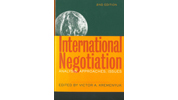
International Negotiation: Analysis, Approaches, Issues
Kremenyuk VA (ed.) (2002). Jossey-Bass, San Francisco, CA, USA, 592 p.

Abstract
The first edition of International Negotiation became a best-selling classic in the field of global conflict resolution. This second edition has been substantially revised and updated to meet the challenges of today's complex international community. Developed under the direction of the International Institute for Applied Systems Analysis, this important resource contains contributions from some of the world's leading experts in international negotiation, representing a wide range of nations and disciplines. They offer a synthesis of contemporary negotiation theory, perspectives for understanding negotiation dynamics, and strategies for producing mutually satisfactory and enduring agreements that is particularly relevant in these times.
Contents
Preface to the 1991 Edition.
Preface to the 2002 Edition.
About the Contributors.
PART ONE: LEVELS OF ANALYSIS.
1. Contributions of Applied Systems Analysis to International Negotiation (Howard Raiffa).
2. The Emerging System of International Negotiation (Victor A. Kremenyuk).
3. The Negotiation Process (Christophe Dupont and Guy-Olivier Faure).
4. Metaphors for Understanding International Negotiation(Victor M. Sergeev).
5. The Structure of Negotiation (I. William Zartman).
6. Strategy in Negotiation (Dean G. Pruitt).
7. The Actors in Negotiation (Jeffrey Z. Rubin).
8. The Outcomes of Negotiation (Arild Underdal).
PART TWO: APPROACHES AND PERSPECTIVES.
9. Historical Approach (Jean F. Freymond).
10. The Legal Perspective on International
Negotiations (Franz Cede).
11. Organizational Theory (Robert L. Kahn) Addendum by (Roy J. Lewicki).
12. Economic Perspective (John G. Cross).
13. Game Theory (Rudolf Avenhaus).
14. International Negotiation Analysis (James K. Sebenius).
15. Psychological Approach (Jeffrey Z. Rubin).
16. Cognitive Theory (Christer Jönsson).
17. Content Analysis (Daniel Druckman with the collaboration of P. Terrence Hopmann).
PART THREE: ISSUES.
18. Arms Control and Arms Reduction: View I (P. Terrence Hopmann with the collaboration of Daniel Druckman).
19. Arms Control and Arms Reduction: View II (Alexei G. Arbatov).
20. Regional Conflict Resolution (I. William Zartman).
21. Negotiation on Trade and the Environment: Variation in the Multilateral Approach (Gunnar Sjöstedt).
22. International Business Negotiations (Christophe Dupont).
23. International Negotiation: The Cultural Dimension (Guy-Olivier Faure).
24. Negotiations with Terrorists (Richard E. Hayes).
PART FOUR: EDUCATION AND TRAINING.
25. Development of Negotiating Skills (Willem F. G. Mastenbroek).
26. Training of Negotiators (Paul W. Meerts).
27. Simulation for Teaching and Analysis (Gilbert R. Winham).
Afterword (Victor A. Kremenyuk).
References.
About IIASA.
Name Index.
Subject Index.
About the Editor
VICTOR A. KREMENYUK, Ph.D., director of science (history), is deputy director at the The Institute for the USA and Canadian Studies, Russian Academy of Sciences. His areas of interest are international conflict resolution, crisis management, and foreign policy negotiation process. He has published more than one hundred works in Russian and other languages, including Processes of International Negotiations (F. Mautner-Markhof, ed.), Windows of Opportunity (G. Allison, W. Ury, and B. Allyn, eds.), and Cold War as Cooperation (R. Kanet and E. Kolodziej, eds.). Since 1988, he has been an IIASA research associate in the Processes of International Negotiations Project. Contributors to the book include I. William Zartman, Guy Olivier Faure, Jeffrey Rubin, and 20 other experts.


